Vogue

March 1966
Photos by Richard Avedon
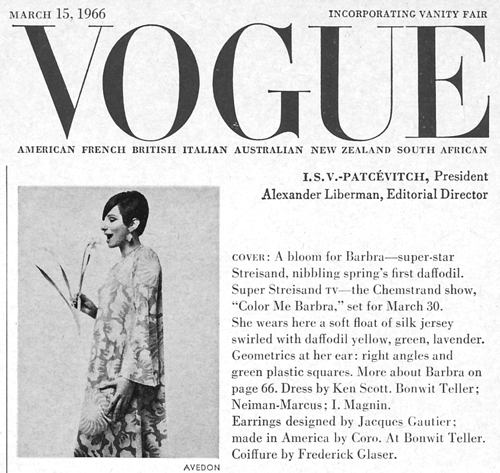
[Barbra Archives Background Note: (from "Fantasy Aisles" by William Norwich) “... soon after My Name Is Barbra was broadcast, Diana Vreeland dispatched the 23-year-old star from Brooklyn to Paris with Richard Avedon. Streisand modeled the couture that season for Vogue, and the results, including coiffures by Alexandre, who did the Duchess of Windsor's hair as well as Princess Grace's, appeared on the cover of the March 15, 1966, issue of the magazine. The Paris trip was paid for by Chemstrand, a fabric manufacturer, and the couture clothes Streisand modeled for Vogue were featured on her next television special, Color Me Barbra, sponsored, naturally, by Chemstrand.”].
The Paris Collections ... with Barbra
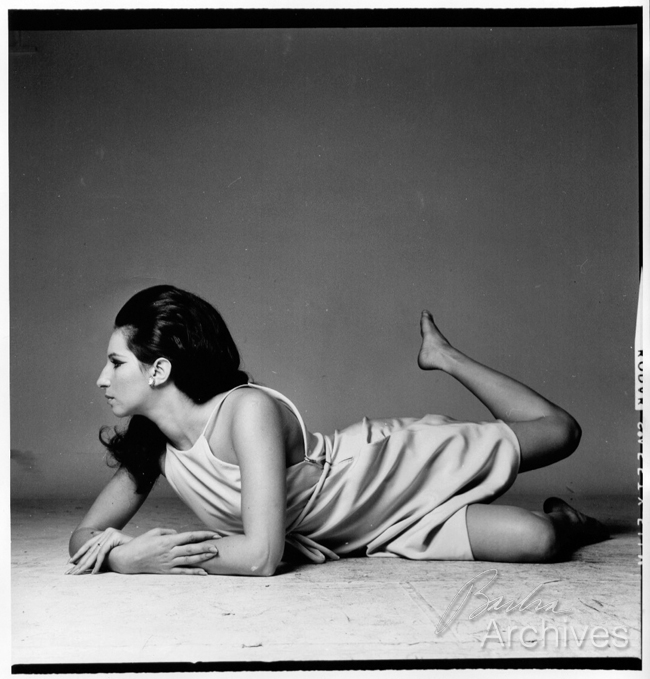
It's spring ... it's a fling ... it's a super-star in heaven: Barbra Streisand wears the new Paris clothes for Vogue. [Barefoot girl in Arab-boy pants: a suddenly long-hair Streisand in a Ricci wow of pale-pink Bianchini silk.]
Elle s'appelle Barbra
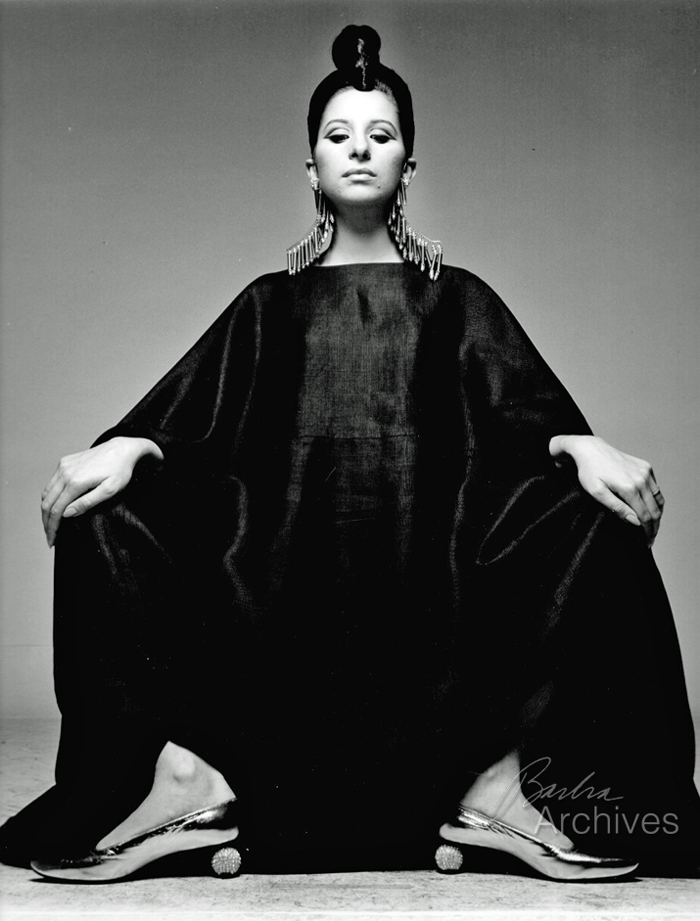
Here, in a navy-linen Grès poncho, and calm as a Buddha, sits Barbra Streisand—on top of the world. More than a star: a style, a fashion, a natural force. "Anyone who doesn't believe in Barbra Streisand," said a believer recently, "is an atheist." ... Without lifting a finger to convert, she converts: suddenly, at auditions, every other young actress does "the Streisand bit"; suddenly a Streisand nose is the interesting nose; let her contemplate long hair and suddenly—a silence of scissors throughout the land ... Streisand, on the other hand, follows no one; she rolls her own—with dead-eye instinct and perfect self-knowledge, she designs clothes for herself, costumes for her TV specials, jacket covers for her record albums; and keeps everyone around her permanently sur le qui-vive (note received by the prop man towards the end of her New York hitch in Funny Girl: "The was flowers are dusty. Love, Barbra") .... In April this Funny Girl explodes in London. And next year, the big one— "the fantasy thing"—Funny Girl on film: "Think! Me! A Movie Star—and pink feathers—that's being a STAH!" In between, two new albums: "Je m'appelle Barbra" and "Color Me Barbra," named after this month's TV special for Chemstrand (whose next Barbra-show will have, as décor, Barbra's own current Paris selections). Colour her triumphant .... Grès poncho, above, of Moreau linen; I. Magnin. Grès ear-sweeps; Roger Vivier gold escarpins. All Paris coiffures: Alexandre.
INSTANT BARBRA
by Polly Devlin
She's a myth, the great American dream, the girl come through, the toast of Broadway, the fable, the moral, and the fairy tale. And most of all she's been to Paris —here in a studio dressing room, where her own voice is singing French songs from a rackety record player and the only thing to do is stare. You see a face that changes from minute to minute, not so much changes as shifts as if she were constantly refocusing her features, anchoring the shifts with her famous unbelievable nose. She is about to meet Madame Grès and it turns out to be a remarkable romantic confrontation of two arts, two generations and continents; one epitomizes France, the other all we secretly think of as American. They complement each other perfectly. Madame Grès elegant, luminous, composed; Streisand glittering, flamboyant, and posed; one in classic sweater and skirt, turban and pearls, the other in a huge flowing poncho, a white nunnish coif, looking as though she had been designed by Le Corbusier.
Streisand in the poncho becomes statuesque, dignified, grand, and faces the camera with a terrible command in her eyes: "Capture me correctly." A minute later in a short, pink culotte dress clowning it up she looks like a four-year-old who has found the hidden bag of sweets: her mood switches unnervingly quickly and it becomes apparent that her moods are induced by externals, by who says what to her, by what she's getting, giving and doing, what Now is doing to her, Instant Barbra.
Streisand's magic is her own. She isn't invested with magic by onlookers, by reputation, by suddenly appearing on stage and singing. She invests that stage—or that room—and gives it magic by filling it with herself. The startling thing about this magic which can't be cut down, put down, explained away, or hidden is that it has little to do with mental attributes, higher intelligence, or wider outlook; it's a matter of personality. To have the magic excludes complacency, and those who have it are inside it. They know about the glow, they can see its effects; but they've never felt the effects and never seen the glow and there's no way of bridging the gap between knowing and realizing. This is our safeguard, the insurance and guarantee that the magic will stay night after night when we've paid our money to see the show. It's the star's weakness as well as strength because she must keep trying, must keep proving by reaction that she is not a colossal bluff. It makes a star demanding company. Streisand has a constant need for reassurance, an ego that can't be sated, a strange vanity, and a frantic pride. She needs to be told what she already knows.
She is capricious as a child, but the caprice is forgivable since under all the attributes of success, adulation, and admiration, underneath the poise, sophistication, and merriment there yawns the lack of self-confidence and the nervousness of youth. This girl is twenty-three, she has shot to stardom in a scant three years. Caprice can be forgiven when you have to cope with that, even though you're built for it, made for it, and have fought and kicked for it. What is alarming is that when she is being bothered—or thinks she is being bothered—she doesn't allow irritation to show; she simply darts out a beam of pure poison from her eyes and lodges it in the annoyer.
Equally she can radiate such warmth and interest that people fall over themselves to get close to the source as though she were the sun. She expects to be the sun in every company, likes the revolving satellites as long as they keep to their orbits. "Noli me tangere," she says from her sloe eyes.... She uses her hands like a Javanese dancer, spelling out a mood with her fingertips, languidly lifting them, or pointing a long horrified finger at a heater that's about to burn up the dressing room, "Hey that's a heater with REAL fire in it." Her hands, like the rest of her, are so cleverly and expertly presented that they appear more beautiful than they are. Which makes them exquisite. Avedon takes the picture. She damns him with her eyes, but when he looks up her eyelashes are benevolently brushing her cheek.
Four hours later she came back for more photographs: she was ill, quiet, and subdued. She had a stunned look on her face as though she couldn't believe les choses could ever turn against her now. She has lost weight already and it's noticeable. The glitter is low. Black mink coat, purple dress, and long alligator boots. Someone says, "What're your boots made of?" She looks at them anxiously for a long time, then shrugs without caring at all and without answering. She sits down in front of the dressing table. "My nose all goes to one side so I'll only do one cheek," she says wielding a blush-on brush in her hand. "That'll bring it back," says Avedon and their glances dare each other in the looking glass. She tells a story of how when she was eighteen a painter used to paint her face with real paint and it was then she learned about planes and shadows; then she became convinced her nose wasn't ugly. "Now I know how I look. I see everything in other people. Wrinkles, lines, you know. Boing." Her voice sounds as though she were snapping elastic. But she's ill and joking's out. Grimacing and clutching the stomach is in and everyone picks up her shattered words and examines them as if they were the last prospectors at a burnt-out gold mine. It's a bad prospect.
Avedon rushes in from the record player blasting out Streisand's own voice and says, "That's my favourite record, just listen to that note, it's the greatest, isn't it?"
"I've never thought about it," she says. He plays it again and she listens, says, "I sure held it a long time. You know, I used to have a fight with the instrumentalist about who would end first. I said we should end together." They end together.
A small vendeuse, economic of body and movement, comes in bearing Saint Laurent's end- of-show fantasy—the bride's dress. It is like the Lady of Shallott's bier and Barbra climbs into it, peering over a thousand sprigs of lily of the valley, waiting until she has been trussed irrevocably into it—arms pinioned. Then blandly, "Imagine if I should throw up now?" She scutters into the studio in bare feet, with this garden of flowers around her shoulder, looking as vulnerable as Ophelia.
On the record her voice rises sweetly to a crescendo. "Turn your body," says Avedon. "But that's my bad side. . . . I've got an itch in my nose. My hair is splitting. . . . At eighteen I dreamed of success and it was much easier because dreams were clear. When you reach success it's no longer exciting. You have to learn and you learn it's never as good as the dream. It's sort of anti-climactic, you know? I don't think I'll ever have enough confidence. I'm never satisfied with anything I do, I never think it good enough. Sometimes when I listen to a record I don't get bothered but I don't get ecstatic either—I hate it when I hear the mistakes. When photographers, people in the street, rush after me, I always think they are going to hit me or something, people coming after me.... I'm depressed now because I'm ill; that colours everything I say but what I've just said about success I mean."
"Hand lotion?" she suddenly yells. "Like you know—hand cre-eeam." Everyone rushes with hand cream. Alexandre, looking like the demon lover and acting like Bambi, does her hair, gives her yards of tresses. She looks marvelous with long hair and knows it. He makes her a present of the hairpiece. ("Fringe bene- fits," warbles Avedon.) And suddenly the stomachache has gone. "C'est uncreeedable," she squeals. "One of those things I've always wanted and never had. Can I wear it in the street? Yeah, and then personne ne me will recognize." Alexandre guesses she is pleased and sparkles when she tells him she'll bring him her new disc tomorrow.
All her luggage is labelled BSG and suddenly the G part arrives, Elliot Gould, her husband, bundled into a trench coat and bearing a gift of baked potatoes. Baked potatoes? In Paris? She falls on them with a spoon. A moment later she is holding her stomach and muttering.
But even though she is ill, and even though just before the camera clicks she has been agonizing, when it does click she looks glowing, dazzling, perfect. And even though she's sick she still can laugh. When she laughs she keeps a cool face. Only when she's smiling does her mouth widen, showing perfect teeth. But it's her living-dying laugh people like most to inspire. Her voice, when she's talking, doesn't promise all she can do with that voice when she's singing.
It's the only thing which doesn't promise; one has only to look at her—and one must look—to realize that hers is that imponderable, enviable quality which has been analyzed so often and which still defies analysis—that quality that lights up a room, a stage, or a continent. She's got it, has Barbra.
Barbra wears Dior and Grès

Barbra à la pensée, Dior à la Turque, above: balooning chiffon pyjamas in layers of luminous, shifting geometrics—brilliant pinks, fuchsia, orange, and acid green. Of Brossin de Méré silk chiffon. Dior earrings. Geometry à la Grès. Below: parti-coloured jersey poncho in yellow and ivory triangled over matching tussah pants, slit to the thicgh on the outside; pressed-in-pleat dead centre. Racine silk jersey. In America, at I. Magnin.
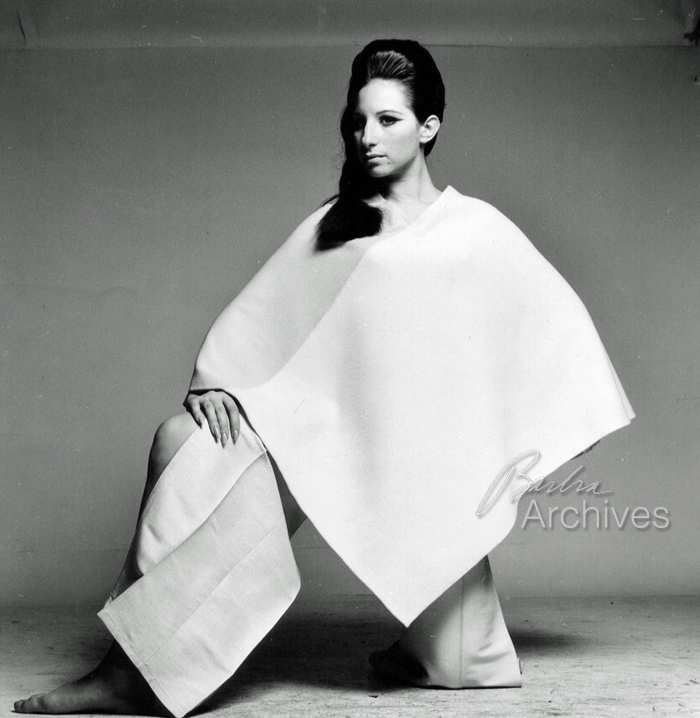
Barbra... wrapped by Grès

"Comme elle est belle," said Grès of Streisand, and wrapped her up tenderly in this delicious little coif—simply a clean white triangle of Moreau linen with a slit for the head and twelve-inch side pieces to tie this way and that. I. Magnin.
End.
Alternate Avedon Photos
An alternate photo of Grès and Streisand: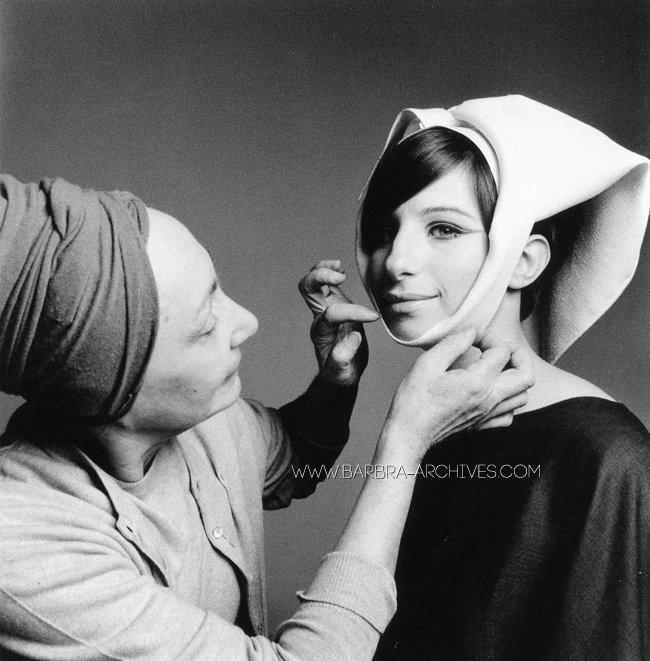
Paris April 1966 Vogue:
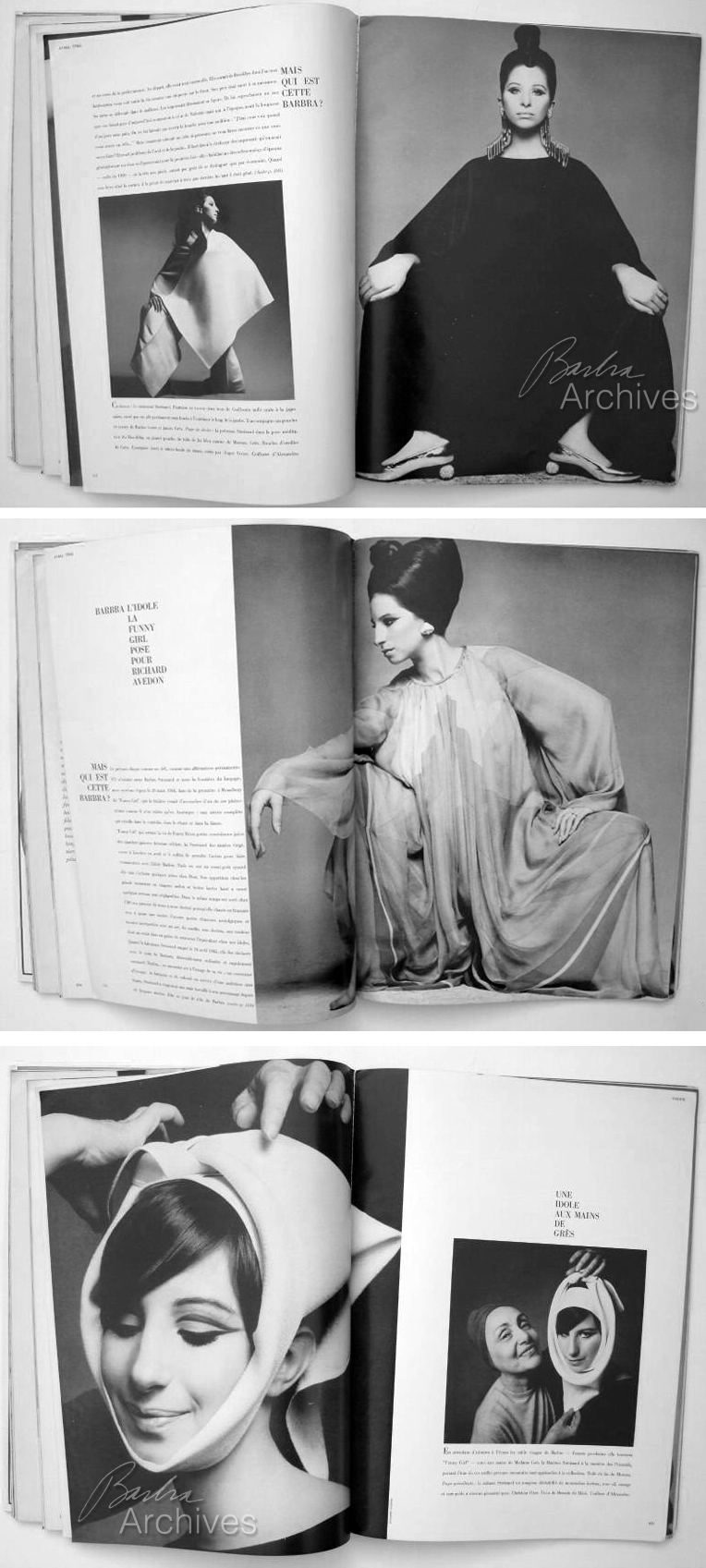
Italian May 1966 Vogue:

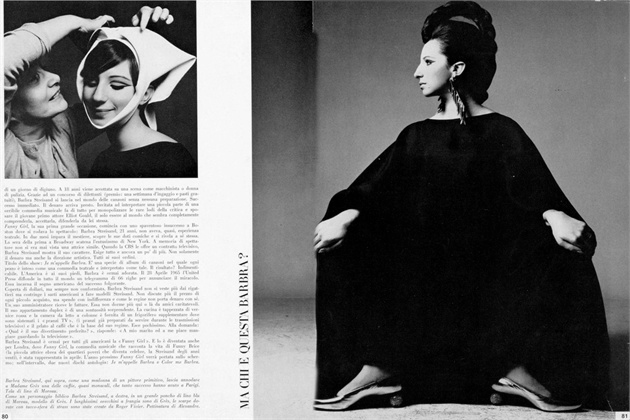
End.
